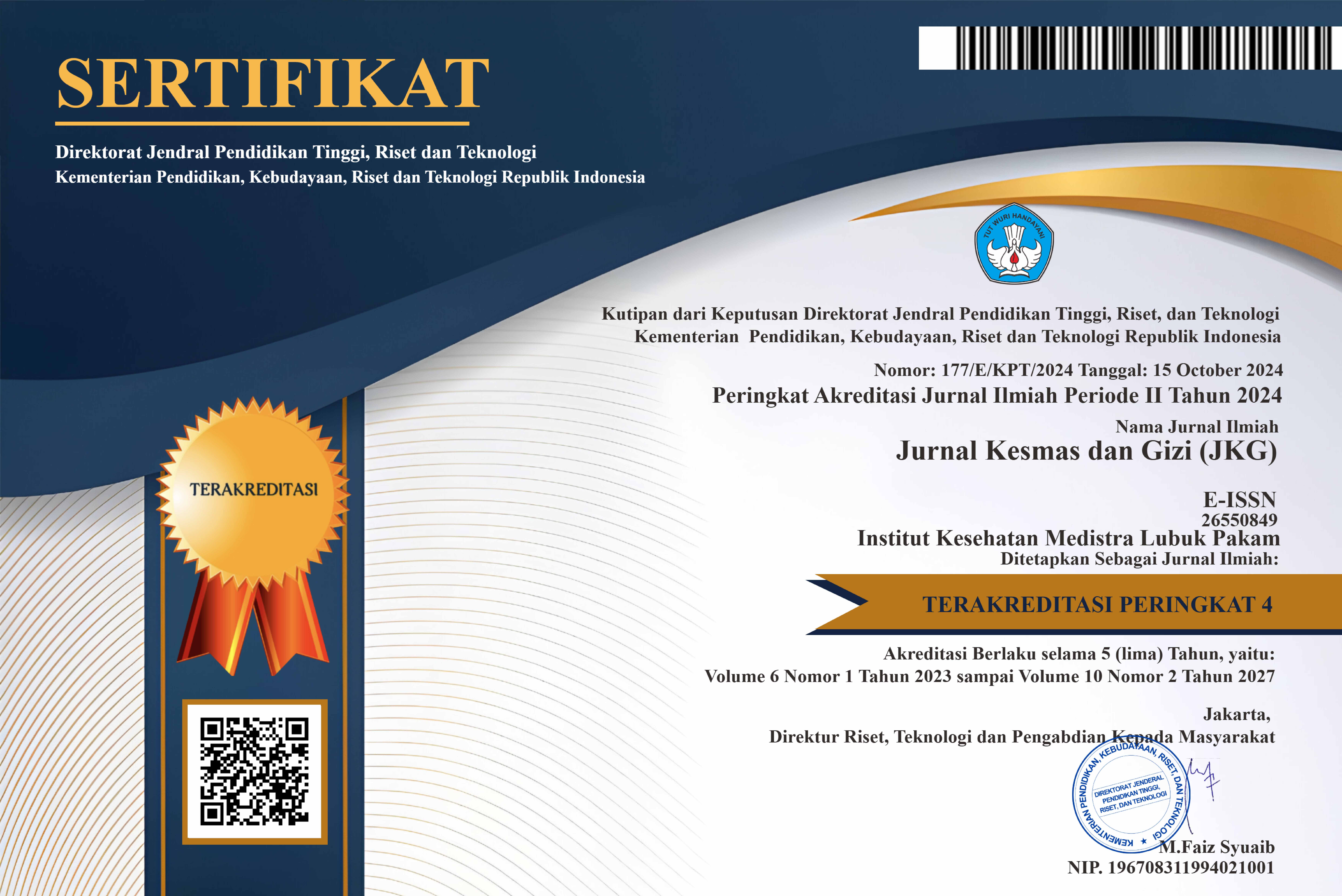THE EFFECT OF EDUCATION THROUGH YOUTUBE TO THE MASTERY OF KNOWLEDGE AND ATTITUDES ABOUT COMPLEMENTARY FEEDING OF MOTHERS WHO HAVE CHILDREN UNDER TWO YEARS AT BUBUTAN SUB-DISTRICT, SURABAYA
DOI:
https://doi.org/10.35451/jkg.v5i1.1359Keywords:
YouTube videos, complementary foods, Nutrition EducationAbstract
Stunting is a nutritional problem in children under 5 years old as seen on the z-score value from the measurement of height for age <-2 standard deviations (stunted) or <-3 (severely stunted). Stunting shows the condition of children who fail to thrive due to chronic malnutrition. In addition to having an impact on physical growth disorders, stunting also affects brain development. Stunting conditions are only seen after the child is over 2 years old and the situation can be more serious if it is not catch-up growth. One of the efforts to reduce the nutritional problems of stunting children is to change the knowledge, attitudes and behavior of parents through education. The purpose of this study was to determine the effect of using videos through YouTube on mothers' mastery and attitudes about MP-ASI in Bubutan District, Surabaya. This research is a quasi-experimental type of research with a nonequivalent control groupThe study sample included 36 mothers who had children under the age of 2 years, divided into experimental and control groups, with 18 respondents in each group. The results of the paired sample t-test showed that there was a significant difference (p = 0.000) between the pretest and posttest values of knowledge and attitudes in both groups. The independent sample t-test (p = 0.000) showed a difference in the average knowledge and attitudes between the use of video media through YouTube and reading sheet about complementary foods. The conclusions of this study indicate that using videos through YouTube can increase the mastery of knowledge and attitudes of mothers who have children under two years about complementary feeding and is better than using reading sheet about complementary foods.
Downloads
References
Apriyanto, Rahmat. (2020). Efektivitas Promosi Kesehatan Melalui Media Youtube Terhadap Pengetahuan Dan Sikap Remaja Putri Tentang Anemia Di Sma Negeri Kota Bengkulu. Skripsi. Bengkulu: Politeknik Kesehatan Kemenkes Bengkulu.
Asian Development Bank/ADB. (2021). Prevalensi Stunting Balita Indonesia Tertinggi ke-2 di Asia Tenggara. (Online), (https://databoks.katadata.co.id/datapublish/2021/11/25/prevalensi-stunting-balita-indonesia-tertinggi-ke-2-di-asia-tenggara).
Azwar, Saifuddin. (2011). Sikap Manusia: Teori dan Pengukurannya. Yogyakarta: Pustaka Pelajar.
Cahyani, Prima Ayu. (2017). Hubungan Pengetahuan Ibu Tentang Makanan Pendamping Asi (Mp-Asi) Dengan Berat Badan Bayi Usia 6-24 Bulan Di Posyandu Temu Ireng Kampung Nalen Sorosutan Umbulharjo Yogyakarta. Skripsi: Universitas Alma Ata Yogyakarta.
Dinas Kesehatan Surabaya. (2022). Dinkes Ungkap Angka Stunting di Surabaya Turun Drastis. (https://www.suarasurabaya.net/kelanakota/2022/dinkes-ungkap-angka-stunting-di-surabaya-turun-drastis/).
Faiqah, F., Nadjib, M., & Amir, A.S. (2016). YouTube Sebagai Sarana Komunikasi Bagi Komunitas Makassarvidgram. Jurnal Komunikasi KAREBA. Vol. 5 (2).
Febriani, C. A., Nuryani, D. D., & Elviyanti, D. (2019). Efektifitas Pemanfaatan Media Gambar Bergerak dan Video Animasi terhadap Peningkatan Pengetahuan dan Sikap Ibu tentang Gizi Seimbang pada Balita. Jurnal Kesehatan. Vol 10(2).
Fitri, L., Ritawani, E., & Mentiana, Y. (2020). Hubungan Asupan Energi Dengan Kejadian Stunting Pada Balita Usia 2-5 Tahun Kota Pekanbaru. Jurnal Endurance : Kajian Ilmiah Problema Kesehatan. Vol 5(3): hal. (591-597).
Haslam, Kimberly. (2019). YouTube Videos As Health Decision Aids For The Public: An Integrative Review. Canadian Journal of Dental Hygiene (CJDH), Volume 53, (1).
Kartini, Neny. (2021). Pengaruh Pendidikan Kesehatan Dengan Media Sosial Youtube Terhadap Pengetahuan Remaja Tentang Premenstruasi Sindrom di SMPN 05 Kota Bengkulu. Skripsi. Bengkulu: Politeknik Kesehatan Kota Bengkulu.
Kominfo Jawa Timur. (2022). Di Masa Pandemi Angka Stunting di Jatim Mengalami Penurunan. (http://kominfo.jatimprov.go.id).
Kompas.com. (2021). Pengguna Medsos di Indonesia Habiskan 25 Jam Per Bulan untuk Nonton YouTube.(https://tekno.kompas.com/read/2021/02/24/17020027/pengguna-medsos-di-indonesia-habiskan-25-jam-per-bulan-untuk-nonton-YouTube).
Leonita, E., & Jalinus, N. (2018). Peran Media Sosial dalam Upaya Promosi Kesehatan: Tinjauan Literatur. Jurnal Inovasi Vokasional dan Teknologi. Vol 18(2).
Lestiarini, Santi., & Sulistyorini, Yuly. (2020). Perilaku Ibu pada Pemberian Makanan Pendamping ASI (MPASI) di Kelurahan Pegirian. Jurnal Promkes: The Indonesian Journal of Health Promotion and Health Education Vol. 8 (1).
Rafika, Muhana. (2019). Dampak Stunting Pada Kondisi Psikologis Anak. Buletin Jagaddhita Vol. 1 (1).
Reza, Muh Jamil. (2021). Persepsi Mahasiswa Terhadap Penggunaan Media Sosial Youtube Sebagai Media Content Video Creative (Studi Deskriptif Pada Mahasiswa Unismuh Makassar). Skripsi. Makasar: Universitas Muhammadiyah Makassar.
Rusnayani, dkk. (2021). Pengaruh Media Audiovisual (Youtube) Terhadap Kepatuhan Konsumsi Tablet Tambah Darah Dalam Mencegah Anemia Remaja di Posyandu Remaja Wilayah Kerja Puskesmas Lasusua dan Tiwu Kabupaten Kolaka Utara. Jurnal Ilmiah Obsgin. Vol.13(3).
Safitri, Vania Arthamevia. (2021). Pengaruh Video Edukasi Terhadap Pengetahuan dan Sikap Ibu dalam Pemberian ASI Eksklusif di Puskesmas Bulu Lor 2021. Media Kesehatan Masyarakat Indonesia. Vol. 20(5).
Survei Status Gizi Balita Indonesia (SSGBI). (2021). Angka Stunting Turun di Tahun 2021. (https://www.litbang.kemkes.go.id/angka-stunting-turun-di-tahun-2021/)
Tim Nasional Percepatan Penanggulangan Kemiskinan (TNP2K). (2017). 100 Kabupaten/Kota Prioritas Untuk Intervensi Anak Kerdil (Stunting). Jakarta.
Wulandari, R. C., & Muniroh, L. (2020). Hubungan tingkat kecukupan gizi, tingkat pengetahuan ibu, dan tinggi badan orangtua dengan kejadian stunting pada balita di wilayah kerja Puskesmas Tambak Wedi Surabaya. Amerta Nutrition PP: 95-102.
Downloads
Published
Issue
Section
License
Copyright in each article is the property of the Author.


























